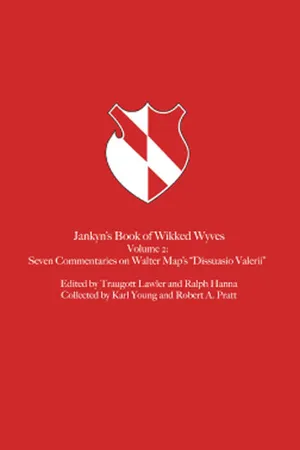
Jankyn's Book of Wikked Wyves
Seven Commentaries on Walter Map's "Dissuasio Valerii"
- 624 pages
- English
- ePUB (mobile friendly)
- Available on iOS & Android
Jankyn's Book of Wikked Wyves
Seven Commentaries on Walter Map's "Dissuasio Valerii"
About this book
In volume 1 of Jankyn's Book of Wikked Wyves (Georgia, 1997), Ralph Hanna and Traugott Lawler presented authoritative versions of three medieval texts invoked by Jankyn (fifth husband of the Wife of Bath) in The Canterbury Tales. In Jankyn's Book, volume 2, Lawler and Hanna revisit one of those texts by way of presenting all the known contemporary commentaries on it.
The text is Walter Map's "Dissuasio Valerii," that is, "The Letter of Valerius to His Friend Ruffinus, Dissuading Him from Marrying." Included in Jankyn's Book, volume 2, are seven commentaries on "Dissuasio Valerii," edited from all known manuscripts and presented in their Latin text with English translation on the facing page. Each commentary opens with a headnote. Variants are reported at the bottom of the translation pages, and full explanatory notes appear after the texts, along with a bibliography and index of sources.
In their introduction, Lawler and Hanna discuss what is known about the authors of the commentaries. Four are unknown, although one of these is almost certainly a Dominican. Of the three known authors, two are Dominicans (Eneas of Siena and the brilliant Englishman Nicholas Trivet), and one is Franciscan (John Ridewall). In addition, the editors discuss the likely readerships of the commentaries—the four humanist texts, which explicate Map's witty and allusive Latin and which were for use in school, and the three moralizing texts, which mount eloquent defenses of women and which were for use mainly by the clergy.
While Lawler and Hanna's immediate aim is to give readers of Chaucer the fullest possible background for understanding his satire on antifeminism in "The Wife of Bath's Prologue," the "Dissuasio Valerii" commentaries extend significantly our understanding of medieval attitudes, in general, toward women and marriage.
Frequently asked questions
- Essential is ideal for learners and professionals who enjoy exploring a wide range of subjects. Access the Essential Library with 800,000+ trusted titles and best-sellers across business, personal growth, and the humanities. Includes unlimited reading time and Standard Read Aloud voice.
- Complete: Perfect for advanced learners and researchers needing full, unrestricted access. Unlock 1.4M+ books across hundreds of subjects, including academic and specialized titles. The Complete Plan also includes advanced features like Premium Read Aloud and Research Assistant.
Please note we cannot support devices running on iOS 13 and Android 7 or earlier. Learn more about using the app.
Information
COMMENTARY THREE:
NICHOLAS TRIVET
Table of contents
- Cover Page
- Title Page
- Copyright Page
- Dedication
- Contents
- Foreword
- Acknowledgments
- Introduction
- Commentary One: “Grues, ut dicit Ysodorus”
- Commentary Two: John Ridewall
- Commentary Three: Nicholas Trivet
- Commentary Four: “Valerius qui dicitur parvus”
- Commentary Five: “Hoc contra malos religiosos”
- Commentary Six: Lambeth 330 (selections)
- Commentary Seven: Eneas of Siena
- Notes
- Bibliography and Abbreviations
- Index of Sources
- Footnotes